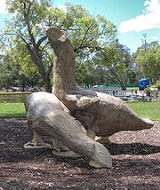
Bullockornis
Encyclopedia
Bullockornis, nicknamed the Demon Duck of Doom, is an extinct flightless bird
that appeared to have lived in the Middle Miocene
, approximately 15 million years ago, in what is now Australia
.
Bullockornis stood approximately 2.5 metres (8 ft 2 in) tall. It may have weighed up to 250 kg (550 lb). Features of Bullockorniss skull, including a very large beak
suited to shearing, indicate that the bird may have been carnivorous. The bird's skull is larger than that of many small horses. Many paleontologists, including Peter Murray of the Central Australian Museum, believe that Bullockornis was related to geese
and duck
s. This, in addition to the bird's tremendous size and possible carnivorous habits, gave rise to its colourful nickname. The bird's generic name is translated as "ox-bird."
Flightless bird
Flightless birds are birds which lack the ability to fly, relying instead on their ability to run or swim. They are thought to have evolved from flying ancestors. There are about forty species in existence today, the best known being the ostrich, emu, cassowary, rhea, kiwi, and penguin...
that appeared to have lived in the Middle Miocene
Miocene
The Miocene is a geological epoch of the Neogene Period and extends from about . The Miocene was named by Sir Charles Lyell. Its name comes from the Greek words and and means "less recent" because it has 18% fewer modern sea invertebrates than the Pliocene. The Miocene follows the Oligocene...
, approximately 15 million years ago, in what is now Australia
Australia
Australia , officially the Commonwealth of Australia, is a country in the Southern Hemisphere comprising the mainland of the Australian continent, the island of Tasmania, and numerous smaller islands in the Indian and Pacific Oceans. It is the world's sixth-largest country by total area...
.
Bullockornis stood approximately 2.5 metres (8 ft 2 in) tall. It may have weighed up to 250 kg (550 lb). Features of Bullockorniss skull, including a very large beak
Beak
The beak, bill or rostrum is an external anatomical structure of birds which is used for eating and for grooming, manipulating objects, killing prey, fighting, probing for food, courtship and feeding young...
suited to shearing, indicate that the bird may have been carnivorous. The bird's skull is larger than that of many small horses. Many paleontologists, including Peter Murray of the Central Australian Museum, believe that Bullockornis was related to geese
Goose
The word goose is the English name for a group of waterfowl, belonging to the family Anatidae. This family also includes swans, most of which are larger than true geese, and ducks, which are smaller....
and duck
Duck
Duck is the common name for a large number of species in the Anatidae family of birds, which also includes swans and geese. The ducks are divided among several subfamilies in the Anatidae family; they do not represent a monophyletic group but a form taxon, since swans and geese are not considered...
s. This, in addition to the bird's tremendous size and possible carnivorous habits, gave rise to its colourful nickname. The bird's generic name is translated as "ox-bird."

